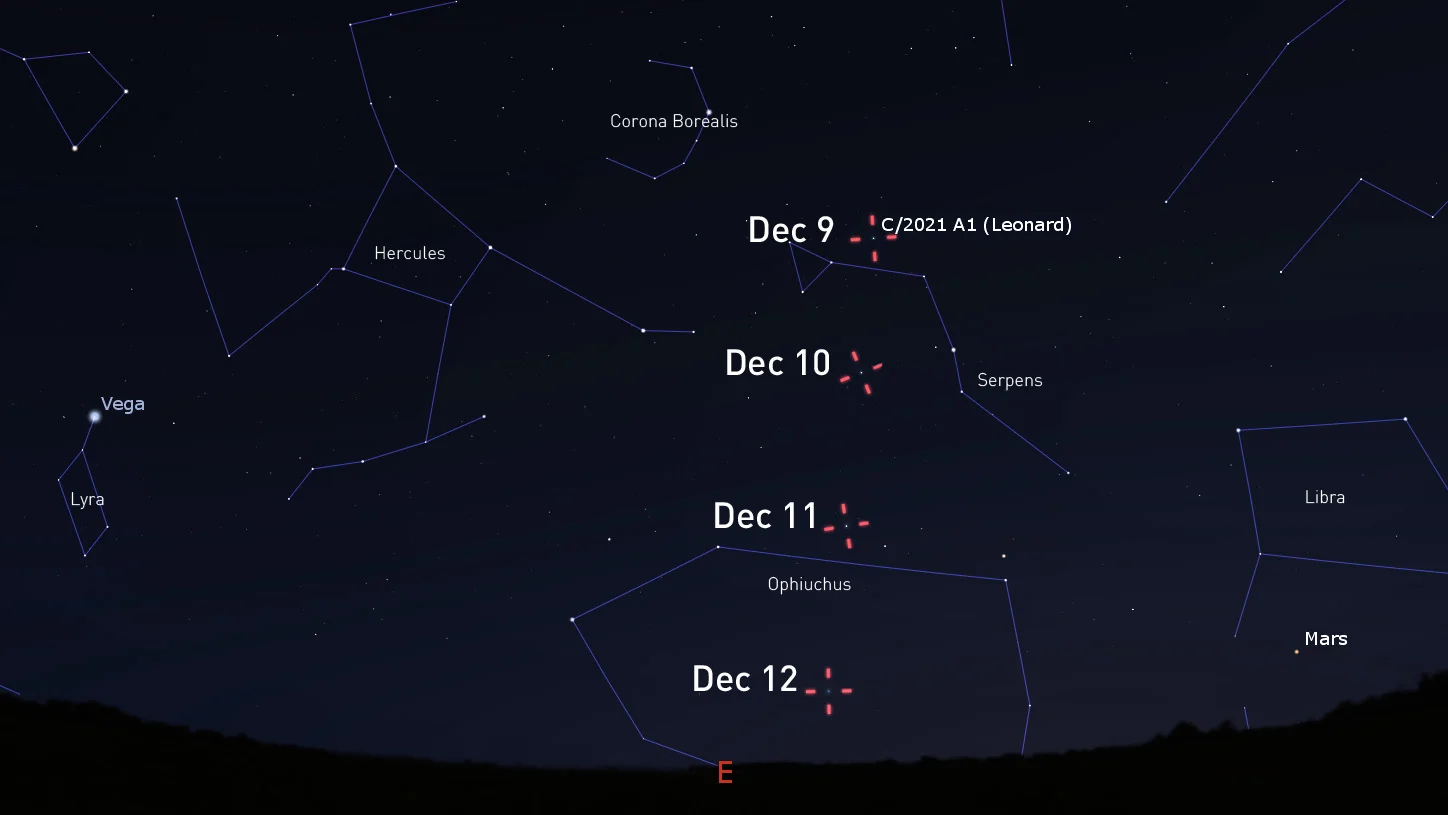
How to see Comet Leonard before it's gone (possibly for good)!
Look to the east before dawn into this weekend to potentially spot this celestial visitor, because this may be the last time we ever see it.
The very first comet discovered this year, Comet Leonard, is visible in the sky this week, and could be bright enough by the weekend to spot with the unaided eye. Be sure to catch it soon, though. Some unusual behaviour from the comet may indicate that it could be in its final days.
There's a very cool sight to see in the eastern sky before sunrise this week.
For those who have clear, dark skies, get outside with your binoculars or telescope on any morning for the rest of this week and look towards the eastern horizon in the few hours before dawn. If you peer closely at the constellation Serpens (between Hercules and Libra), you may spot a new visitor to our skies — Comet Leonard.
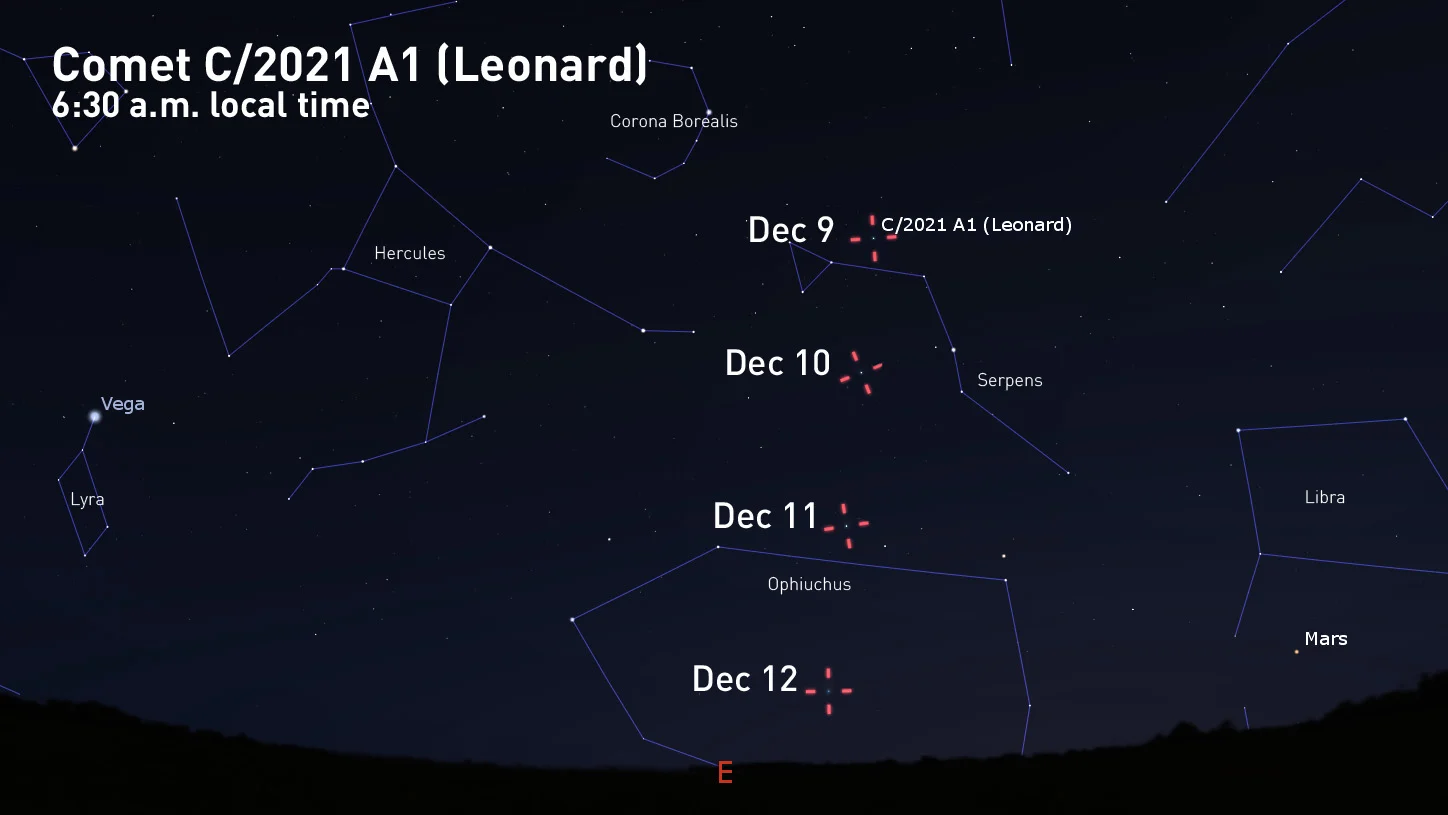
The position of Comet C/2021 A1 (Leonard) on the mornings of December 9 to 12, 2021. Credit: Stellarium/Scott Sutherland
The above graphic shows the comet's position in the sky at around 6:30 a.m. local time for the rest of this week. The timing of when the comet rises changes morning by morning, though. It crests the horizon at around 4:30 a.m. on December 10, 5:10 a.m. on December 11, and 6:05 a.m. on December 12. By the 13th, the comet will be lost in the morning glow of the Sun.
Each morning, though, the comet is expected to progressively brighten so that, by Sunday morning, you may not need binoculars or a telescope to see it!
There's one detail to note, however: city light pollution will make it more difficult to spot this comet. So, for best viewing, it would be in the best interest of city-dwellers to take a short trip outside of city limits.
Watch below: Want to escape urban light pollution? Here are some tips...
Watch for the comet to return in the evening on Monday, December 13, visible in the southwestern sky, very close to the horizon. On the evening of December 16, it will line up with Jupiter, Saturn, and Venus, making it easier to find.
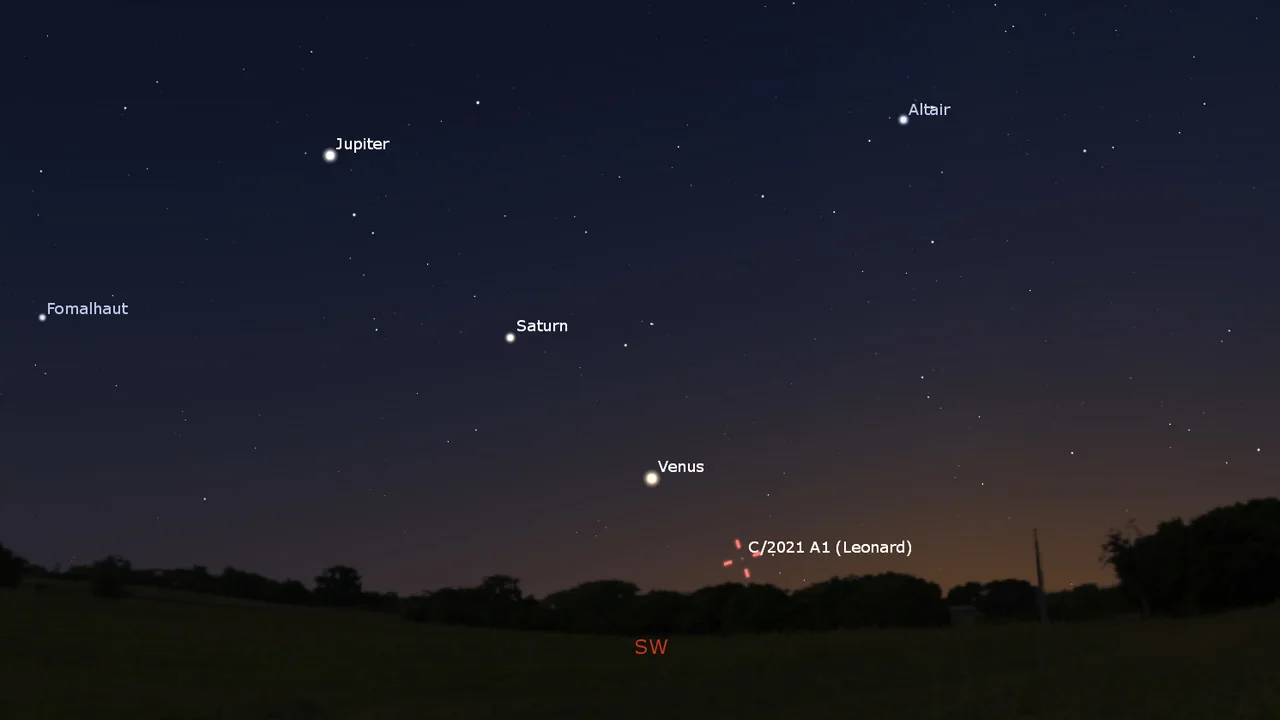
Comet Leonard's position in the evening sky, at around 5:45 p.m. local time, on December 16, 2021. Venus, Saturn, and Jupiter form an alignment with the comet at this time. Credit: Stellarium
WHAT IS COMET LEONARD?
Comet C/2021 A1 (Leonard), the first comet discovered this year, was spotted by astronomer Greg Leonard, using the Mount Lemmon Observatory, on January 3, 2021. At the time, this kilometre-wide chunk of ice, dust, and rock was just inside the orbit of Jupiter and headed inbound towards the Sun.
Over the past 11 months or so, astronomers have been watching Comet Leonard with great interest as it continued its dive through the inner solar system. Some have been capturing some truly amazing images as it has drawn closer to Earth.
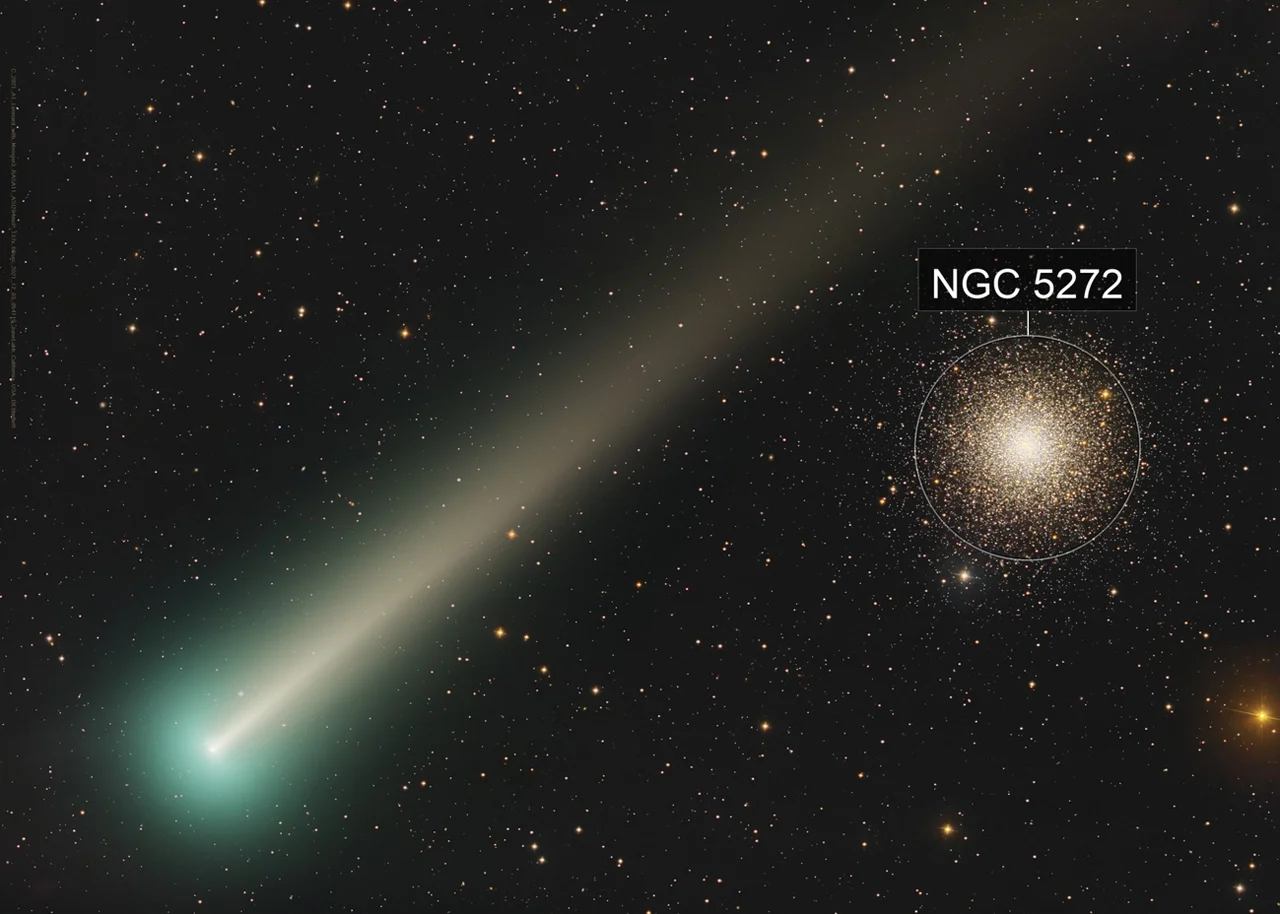
This closeup of Comet Leonard was imaged on December 3, 2021, by Dan Bartlett, from June Lake, California. Also visible in the image is Globular Cluster M3. (Used with permission)
The comet is expected to reach its closest distance to Earth on the morning of December 12. At that time, it will be roughly 35 million kilometres away from us.
That's actually fairly close to the planet Venus, and by December 18, it will have gotten even closer to our planetary neighbour, passing by at a distance of around 4 million km.

Astronomer Gregg Ruppel captured this view of Comet Leonard on December 8, 2021, from Animas, NM. (Used with permission)
According to what astronomer Jonti Horner from the University of Southern Queensland told ABC News Australia, that is the closest any comet has come to Venus in recorded history.
The comet is expected to reach perihelion — its closest distance to the Sun — on January 3, 2022, exactly one year after its discovery. However, that's only if it survives that long.
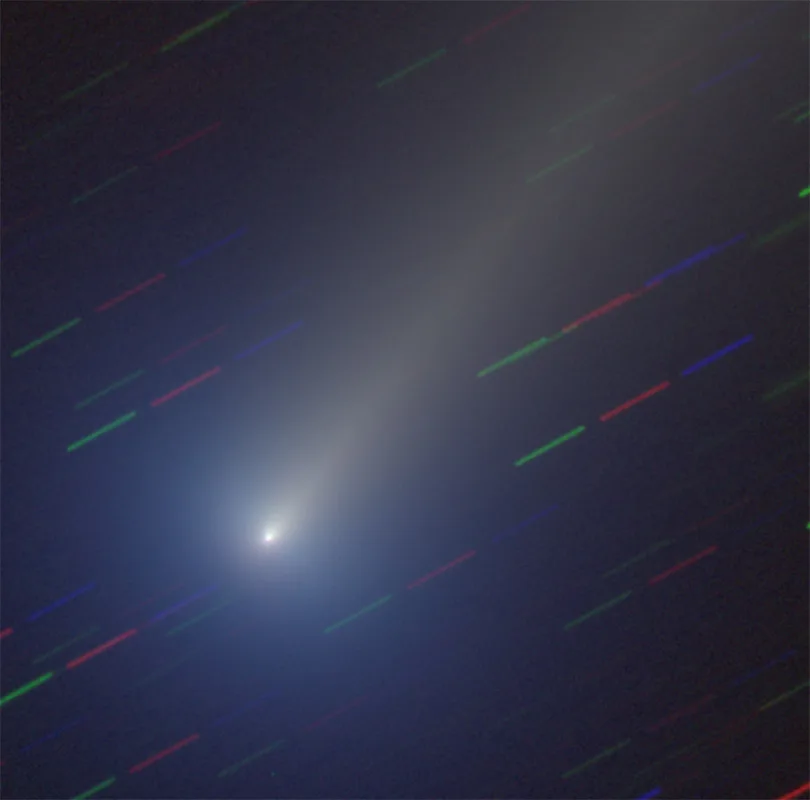
This colour close-up of the comet was produced by superimposing 90 different 5-second images, combining their collective brightness to bring out the details. The background stars are shown as multicolour dashed lines due to the three filters the astronomers used when imaging the comet. The individual images were captured on the morning of 7 December 2021, using the Calar Alto Schmidt telescope in Spain. Credit: ESA/NEOCC
FOR THE LAST TIME?
Although Comet Leonard is putting on a good show for astronomers now, it appears to be dimming, and that could be bad news.
Comets get brighter in our sky for two reasons: 1) because they get closer to us, and 2) because they get closer to the Sun.
The first is simple physics. Any celestial object — a planet, moon, asteroid or comet — will get brighter as we draw closer to it, because we receive more of the light the object reflects. Conversely, it will get dimmer as it gets farther away.
The second is due to the comet's activity. Comets are large chunks of ice mixed with rock and dust. As one approaches the Sun, sunlight heats its surface, causing the ices to turn directly into gas. This forms a cloud of gas and dust around the comet core, which is known as the coma. The coma can be many times the size of the nucleus, which greatly increases the amount of sunlight reflected from the comet, making the comet intrinsically brighter. Typically, the closer the comet is to the Sun, the more active it is, and the brighter it looks.
The combination of these two factors determines how bright the comet should look in our skies at any time.
According to astronomer Quanzhi Ye, an expert on comets and asteroids at the University of Maryland, the only reason Comet Leonard is currently growing brighter for us is because it is still getting closer to Earth. When it comes to the intrinsic brightness, due to the comet's activity, it is actually growing dimmer.
"The comet should be brighter and brighter," Ye told Space.com. "If it's not getting brighter then something's wrong, but we don't know exactly what at this stage."
There are a few reasons for a comet to dim. Some, like 2003 EH1, the source of the Quadrantid meteor shower, have passed around the Sun so many times that they exhaust their supply of ices. Thus their coma fades away. However, the simplest reason, according to Ye, is that something may have gone wrong with the comet.
Along with the increased activity from the comet as it draws closer to perihelion, also comes increased stresses on the nucleus' structure. If those stresses become too much — and how much is "too much" varies from comet to comet — it could just shatter.
This is exactly what happened to Comet ATLAS in 2020. First discovered late in December 2019, C/2019 Y4 (ATLAS) dimmed noticeably in early April, just as it approached the same distance Earth is from the Sun. It was confirmed shortly after that the comet had fractured into multiple pieces. Ye was the researcher who led the study of these fragments, using the Hubble Space Telescope.
So, as we watch this comet in the days ahead, there is the possibility that it may disintegrate before our eyes.
Even if the comet does survive this pass around the Sun, though, this may still be the last time anyone in this solar system sees it!
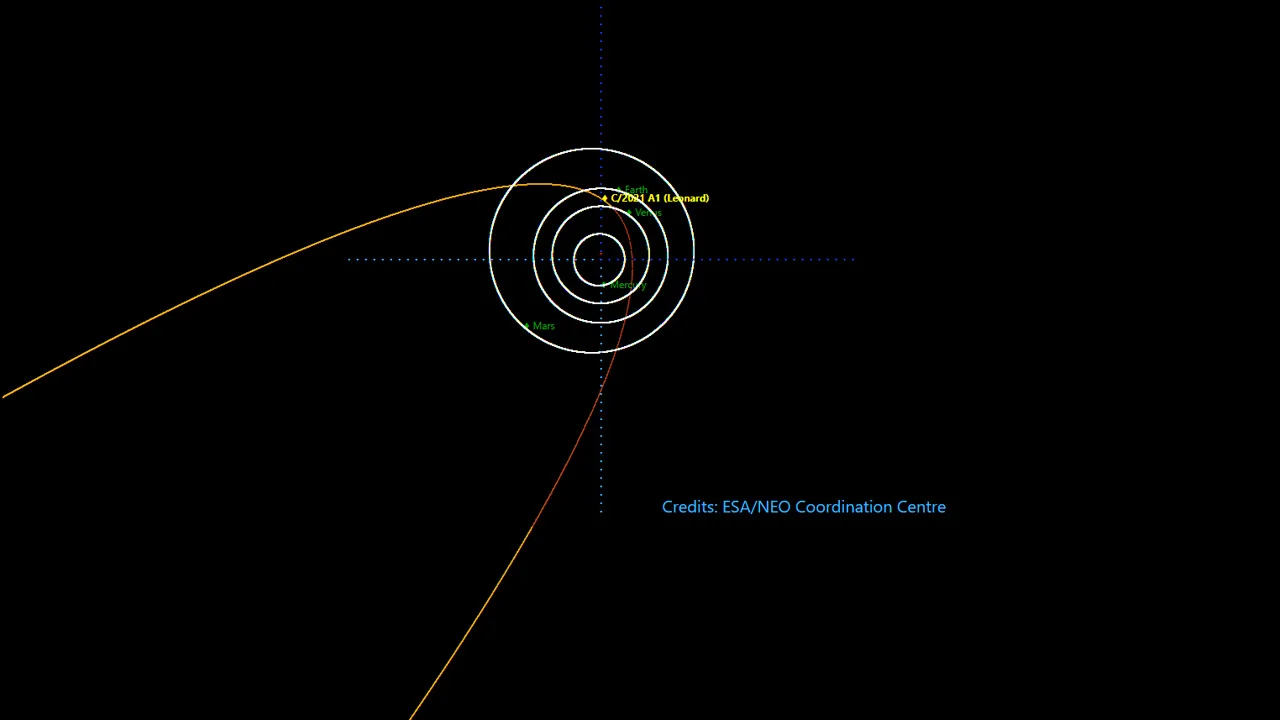
This graphic shows the orbital path of Comet C/2021 A1 (Leonard) through the solar system. Credit: ESA
Astronomers estimate that it has taken Comet Leonard around 40,000 years to make the trip from the outer solar system to this close pass around the Sun. So, if it returns, it will be another 80,000 years before anyone who happens to be on Earth can see it. However, it's possible that this comet may never return.
Based on calculations of its orbit, as Comet Leonard whips around the Sun, it is expected to pick up enough speed to be ejected from our solar system. Essentially, unless the it disintegrates, it will likely become an interstellar comet, similar to 2019's Comet Borisov!
So, we better get out to see this comet now, if we can. One way or another, it will be the last time anyone here sees this celestial visitor.










